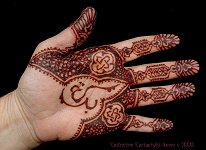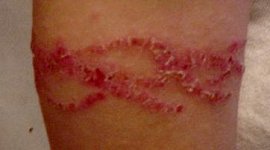Traditional
100% pure henna is SAFE!
 100% pure henna stains skin
in some
color between orange, red, burgundy, brown or coffee.
100% pure henna stains skin
in some
color between orange, red, burgundy, brown or coffee.
The FDA classifies 100%
pure henna
as so safe for hair that it is exempt from regulation.
Traditional pure henna
rarely
causes any difficulty on the unbroken skin of a healthy adult.
Henna
should NOT be used on infants, or children
known to have G6PD deficiency.
Click on links for more information!
Click
here for more information on safe, traditional henna.
See below for additives that
should
be avoided.
"Black
henna" is NEVER 100% pure henna,
and
is often NOT SAFE!

go
here for full story
Do you want to use
"Black Henna"?
Artists who use PPD based
"Black
Henna" put their health at risk.
Do you have a "Black
Henna" tattoo
that's starting to blister and itch?
You've been sensitized to PPD,
para-phenylenediaime,
and you MUST go to a doctor!
See: http://www.hennapage.com/henna/ppd/gotodoctor.html
What
is "Black Henna"?
Henna is NOT black.
If someone
offers you something called "Black Henna", it is NOT henna.
If someone has something that stains skin black, it is NOT
henna.
The black dye is probably para-phenylenediamine, also known as PPD, and
that can hurt you.
PPD, or
para-phenylenediamine is
a snythetic coal tar dye, and causes severe reactions in some people.
Want
to see pictures of how miserable this is?
See: http://www.hennapage.com/henna/ppd/ppdburngallery.html
Sensitization to PPD is
life-long
and has ruined some people's health. See: http://www.hennapage.com/henna/ppd/wilson.html
The International
Chemical Safety Card for PPD gives a clear indication of how
dangerous
it can be and how utterly inappropriate it is for skin
application.
If your "Black Henna"
tattoo is starting
to itch and blister GO TO A DOCTOR! NOW!
See: http://www.hennapage.com/henna/ppd/gotodoctor.html
How do you know if what
you see
is "PPD Black Henna"?
PPD paste is jet black.
Ask how long it takes to
stain and
how long it lasts. If the answers are "just an hour or two" and "a week
or more", it's PPD.
Ask what colour it will
give. If
the answer is "pure black", it's PPD.
Ask to see an ingredients
list.
If the artist can't supply one, or you don't like what you see, walk
away.
PPD is not the
only ingredient
used to make black henna. There are also other chemical dyes in
use,
but none of them stains as fast or as black, or lasts as long as PPD.
Some
of these dyes may be safe, some may not. Ask to see an ingredient
list. If you're not comfortable with what you see, don't use it.
Don't
do a skin
test with PPD
"black
henna". Your skin might not react to PPD the first time you
use
it. Since the reaction can take three weeks or more to show, or in some
cases appears only after a second exposure, it is not safe to assume
that
a 24 hour skin test is going to tell you if you are sensitive. It
will only make you more likely to develop a sensitivity. Just
don't
use it at all!
The International
Chemical Safety Card recommends the wearing of protective gloves
and
protective clothing when handling PPD and warns "Exposure may result in
death". Do you really want to put this stuff on your skin? Do so and
you
might find yourself in the same situation that Mandy
or Thomas
did. Or Brian,
or Noelle,
or Allan,
or Michelle,
or Sarah,
or Alan,
or Debra
...... I hate having to add names to this list.
However, I
was very
pleased to see one success
story. If you follow this link, do read through all the follow-ups.
It will give you some idea of the depth of feeling there is about this
subject.
More
information about PPD is available.
Pure
Henna is SAFE. Pure henna has been
in
use for thousands of years. It's one of the safest things you can
put on your skin, and reactions are very unusual.
Henna ONLY stains a color
in the
range of orange, red, brown, cinnamon, brick, chocolate or coffee.
If you've never used henna
before,
you may want to do a skin test to be sure you're not allergic.
The
allergy is called a "napthoquinone sensitivity". If you put henna
on your skin, and in 1 hour have itching, a tight chest, or wheezing,
you
have a napthoquinone sensitivity and you should not ever use
henna.
"Colored Henna":
Henna is NEVER blue, yellow,
green,
purple or black. If a product stains skin those colors, it is NOT
henna. Those stains come from other dyes. Ask what dyes
those
are. If the supplier can't or won't tell you what dyes those are,
and prove it, or you don't like the sound of what they tell you, don't
put the stuff on your skin. Smell the product. If it smells
scary, don't put it on your skin.
Essential Oils:
Artists often add essential
oils
such as Tea Tree, Eucalyptus, Cajeput and others to henna paste
to
"terp" them, and make the stain quicker and darker. If these are from
aromatherapy
grade essential oils containing monoterpene alcohols, this is a safe
and
effective way to make henna very dark. Many of these give wonderful
results,
are fragrant and harmless. Some may cause minor skin
irritation.
See: http://www.hennapage.com/journal/issue_III/article_3/page1.html
and http://www.mehandi.com/how/howmix/howmixi7.html
for complete details on safe and effective use of essential oils that
have
high levels of monoterpene alcohols.
Gasoline, Kerosene,
Lighter Fluid:
Some henna artists in India,
Africa
and Arabia use acetone, lighter fluid, turpentine, gasoline and
dry
cleaning fluid in their henna mixes to get near black stains.
This
is DANGEROUS! If you smell these solvents in henna paste, do not
put it on your skin. If it's already on your skin, wash it off as
quickly as you can.
Camphor:
Some Indian henna artists use
camphor,
or white flower oil (which includes camphor) in their henna to make
very
dark stains. Camphor may make both the artist and client
nauseous,
dizzy, intoxicated or very ill. Do not put camphor or products
that
include camphor in henna paste.
Citrus Oils:
Citrus oils can darken henna,
but
they can also leave itchy welts on the skin, or increase sun
sensitivity.
If henna paste smells like lemon peel or citronella, it may make you
itchy.
Walnut powder:
Some people include walnut
powder
in their henna mix to help darken the stain. Many people are allergic to walnut and this may
cause
a rash on their skin. If they are very sensitive, there is a risk
of inducing anaphalactic shock!. Always ask clients if they have a nut
allergy before applying walnut powder paste to their skin. Or play safe
and leave it out of the mix.
Black Kattam:
This is not henna. However, it
is
dark brown dye which contains ingredients that may cause skin
irritation.
Black Rocks from the
Nile and
"Henna Stone":
Someone, somewhere, in the
supply
chain in the Middle East is selling a solid form of industrial grade
PPD
and is lying about what it is. There is no such thing as a black
rock that will make henna black. There is no such thing as a
"henna
stone". These are lies told to gullible people by someone who
wants
to make a huge profit on PPD. If it's black, stains quickly and
stays
black for more than 4-5 days, its PPD, and it can hurt you!
Can't find what you want
here?
Try The Henna
Page
Main Index.
|


